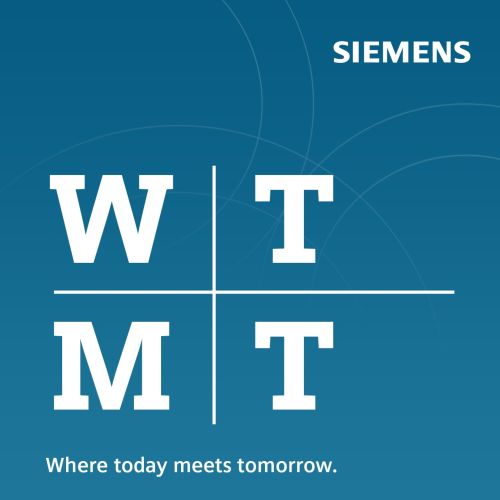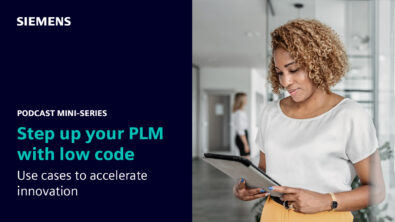WTMT#2: Industry 4.0 and manufacturing’s response to COVID-19 with Brian Sniegocki and Tom Tengan

In episode two of Where Today Meets Tomorrow, Ginni Saraswati talks with not one, but two experts on manufacturing in the modern age. They discuss how to safely restart production lines during a pandemic. Spoiler alert: real-time locating systems (RTLS) and radio frequency identification (RFID) can go a long way in helping manufacturers keep employees safe while operating efficiently. (You can learn more about Siemens’ SIMATIC RTLS here).
Our first guest is Brian Sniegocki, a Senior Business Analyst with Dana Corporation where he is responsible for running a global quality system. Joining him is Tom Tengan, Director of Digital Enterprise at Siemens. Combined, the two possess more than 40 years of experience in manufacturing and industry. Throughout their careers, Brian and Tom have experienced significant shifts in the technologies and processes available to manufacturers. They talk about this and more with Ginni.
Industry 4.0 and manufacturing’s response to COVID-19 | Brian Sniegocki (Dana Incorporated) and Tom Tengan (Siemens)
We have entered the fourth industrial revolution, and things have been moving along without a hitch. Digitalization within manufacturing is becoming more and more common as the speed of technology continues to increase. By the end of 2019, things were looking really good. Then, as if out of nowhere, we were suddenly thrown a curveball.
The COVID-19 pandemic has thrown a pretty sizable wrench into our lives. It’s changed the way we go about our day to day activities, how we interact with one another, and how we move around the world. It has equally shocked the business sector, as companies across the globe attempt to navigate new systems of daily operations and communications within a cloud of uncertainty.
Our guests today are Brian Sniegocki and Tom Tengan. Brian runs a global quality system at Dana Incorporated, with the admirable goal of making people’s jobs easier. Tom started as a Design Engineer in the aerospace industry before becoming a Director of the Digital Enterprise team at Siemens. Together they bring 40 years of experience to our wondering ears.
As an industry built on continuous innovation, progress can’t take a backseat – even through a pandemic. In today’s episode, we talk about how companies are learning to operate within this new normal, while continuing to innovate. We discuss how the industry manages to keep workers safe, and how we can communicate these new measures to employees in a clear and concise way. We also talk about an innovative software solution that can help ease the transition to a safer workplace as we implement so many changes at once.
Some Questions I Ask:
- How can RTLS help with these workplace issues? (7:20)
- What is RFID? (9:38)
- How does Compliant Pro help solve these problems? (12:40)
- How does the digital twin come into the equation? (18:19)
- Will companies still be willing to invest in IT and digitalization during difficult times? (19:21)
- How would you advise technologists who are just starting out in the field, wanting to plot their career path? (21:15)
What You’ll Learn in this Episode:
- A brief story about the early, early days of the Industrial Revolution (0:06)
- Words of wisdom on the uptake of digitalization (3:15)
- The biggest issues to consider in returning employees to the workplace (5:00)
- How a software is making it easier to virtually navigate facilities (15:10)
- How young engineers can set themselves apart from the competition (23:44)
Connect with Brian Sniegocki:
Connect with Tom Tengan:
But, where did this all start? Manufacturing, that is.
Ginni goes back, way back, and begins this episode with the story of Cromford, a small village nestled in the Derbyshire Dales in the center of England along the banks of the River Derwent. Despite its modest scale, Cromford can claim a rather large honor: the birthplace of the modern factory and a key site in the development of the Industrial Revolution.
How did such a small village become home to such a world-changing development? It all comes down to Sir Richard Arkwright, a barber and wig maker turned inventor and, eventually, leading entrepreneur during the Industrial Revolution.
Starting in the early 1770s, Arkwright constructed a mill complex in Cromford that became both the first water-powered mill and, more importantly, the first factory to feature a continuous production process from raw materials to finished product. The Cromford Mill combined waterpower, machinery and semi-skilled workers to enable mass-production of cotton yarn. It also showed the world what was possible.
In the nearly 300 years since the construction of Arkwright’s mill, two more industrial revolutions have completely changed the ways we work and manufacture products. Now, we are hurtling along in Industry 4.0, in which traditional manufacturing and industry is automated, machines are connected to the internet and digitalization enables new connections between domains, teams and people. However, even with the remarkable advances made by large scale manufacturers; disaster can still strike. The coronavirus pandemic has sent the manufacturing industry reeling. Now, manufacturers not only have to find ways of accelerating production and reducing product faults through digital technologies, they must also learn how to use tech to improve safety measures within their facilities.
We hope you enjoy the episode, and thanks to Brian and Tom for joining!

Brian Sniegocki – Speaker
Brian Sniegocki is a Sr. Business Analysis with the Global Quality Systems team of Dana Corporation, a Fortune 500 company and one of the largest suppliers of parts and components to the automotive industry. He is current working on integration projects for Quality, Engineering and Manufacturing systems as well as redefining business processes.
In 30 years in the industry he has published three technical papers on Engineering Systems Automation and Software Development and has been a contributing author to various publications including the AIAG CQI-13 Technical Implementation Guide for eAPQP XML Schemas.

Tom Tengan – Speaker
Tom Tengan is the Director of Digital Enterprise at Siemens, and is a passionate advocate for the disruptive potential that can be realized through digital transformation. He is responsible for aligning client business objectives with strategies to leverage a robust and scalable portfolio of solutions that enable the creation of Digital Twins from product ideation through realization and ultimately to utilization. During his 25 years with Siemens, Tom has worked with clients across multiple vertical industries to manage the intersection of people, process and technology to dramatically improve product development and manufacturing performance through the implementation of PLM, MOM and Automation technologies.

Ginni Saraswati – Host
Ginni Saraswati hosts and produces Where Today Meets Tomorrow. She is CEO of New York City-based Ginni Media, an award-winning journalist, multi-award nominated podcaster, and veteran on-air radio host/personality from Melbourne, Australia.

Where Today Meets Tomorrow
Explore the topic of digital transformation in industry in Where Today Meets Tomorrow, a Siemens podcast. The conversations are fun and lighthearted, accessible to everyone from your CTO to your mom. Complexity and change are hallmarks of our industry and modern life generally, but one constant is that all of us working in and impacted by digitalization have a story to tell. What’s yours?

Where Today Meets Tomorrow Podcast
Amid unprecedented change and the rapid pace of innovation, digitalization is no longer tomorrow’s idea. We take what the future promises tomorrow and make it real for our customers today. Welcome to “Where today meets tomorrow.”
